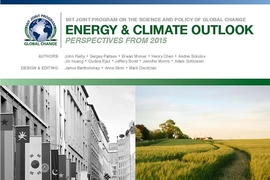A key concern at the Paris climate negotiations (COP21) is to find a fair, effective, and economically viable way to curb greenhouse gas (GHG) emissions in developing countries, which are expected to vastly outpace those produced in developed countries in the coming decades. One approach, adopted in previous United Nations climate summits in Copenhagen and Cancun and now implemented in Paris, is to encourage each country to craft its own climate mitigation policy based on local conditions and challenges. Another strategy, favored by many economists as the best way to reduce global emissions but politically challenging to implement, is to base each country’s contribution to international climate mitigation efforts on a “one-size-fits-all” policy such as a universal carbon price or emissions reduction target.
In a study in the journal Energy Economics, researchers at the MIT Joint Program on the Science and Policy of Global Change explored the implications of establishing uniform emissions reduction policies in Brazil and Mexico, which have the two largest economies in Latin America and are well-positioned to engage the developing world in climate negotiations. Using the MIT Economic Projection and Policy Analysis (EPPA) model to determine the economic impact of several climate policy scenarios on Brazil and Mexico between 2020 and 2050, they showed that imposing the same carbon prices or GHG emissions targets on each country would cost about twice as much in Mexico as in Brazil.
In Mexico, the largest contributor to GHG emissions is the energy sector; in Brazil, it’s the agriculture sector. Due to differences in energy and land use emissions sources, the same climate policies cost much higher in Mexico under scenarios ranging from extending existing commitments made in Copenhagen and Cancun to 2050, to a more stringent policy aimed at halving all GHGs by 2050 relative to 2010 levels. In the latter scenario, GDP losses between 2020 and 2050 range from 4 percent to 11 percent for Mexico and 0 percent to 4 percent for Brazil.
These findings highlight the need for climate policies that account for individual countries’ natural resources, emissions profiles, and economic structures. Even among countries at similar levels of economic development such as Brazil and Mexico, GHG mitigation efforts come with significantly different costs and benefits that cannot be glossed over in a one-size-fits-all policy.
“We expect our research to assist in international climate negotiations and policy design by better explaining the costs and conditions that influence different countries’ positions,” says the study’s lead author, Claudia Octaviano, a recent Joint Program postdoc who now serves as general coordinator for climate change and low-carbon development at the National Institute for Ecology and Climate Change of Mexico. “This type of analysis may also assist developing countries in crafting appropriate mitigation actions by comparing the implications of proposed policies with other countries.”
To produce their findings, Octaviano and her co-authors — Joint Program Deputy Director Sergey Paltsev and research associate Angelo Gurgel — updated the EPPA model to incorporate the most recent emissions inventories in Mexico and Brazil, and key national initiatives such as Brazil’s policy to reduce deforestation. Policy scenarios were developed by the Latin America Modeling Project and the Integrated Climate Modeling and Capacity Building Project in Latin America. The EPPA model allowed for a comprehensive analysis of all sectors of the global economy and all GHGs, providing a one-stop-shop for policy design and comparison.
“Because we represent the global economy in a single framework, we can capture responses that other models ignore, including the trade implications of climate policy,” Octaviano explains. “We also have the capability to consider changes in land use, allowing us to model Brazil’s deforestation policy within the same framework.”
The study was funded by the Mario Molina Center, the National Council for Science and Technology of Mexico, the National Council for Research of Brazil, the European Union and sponsors of the MIT Joint Program.










